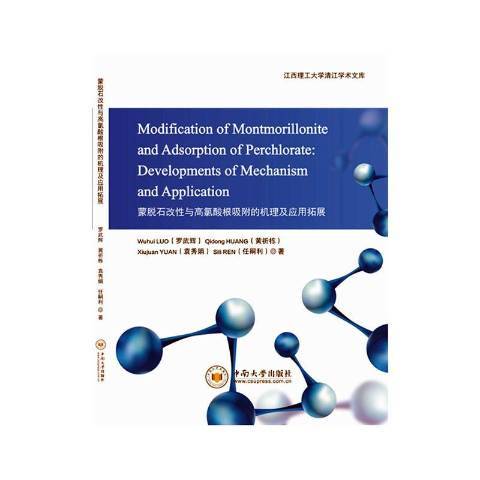《蒙脫石改與高氯酸根吸附的機理及套用拓展》是2020年中南大學出版社出版的圖書。
基本介紹
- 中文名:蒙脫石改與高氯酸根吸附的機理及套用拓展
- 作者:羅武輝,黃祁棟,袁秀娟 等
- 出版時間:2020年5月
- 出版社:中南大學出版社
- ISBN:9787548740216
- 類別:地質學
- 開本:16 開
- 裝幀:平裝-膠訂
內容簡介,圖書目錄,
內容簡介
本書凝聚了作者多年的科研成果,在理論和套用方面都進行了深入地論述和創新。第1章介紹了新興污染物高氯酸根的生物毒性與相關處理技術,分析了有機改性蒙脫石在環境修復中的套用與研究現狀。第2章概括了本書涉及的固相表征技術及吸附模型。第3章通過甄選六種不同分子結構的傳統有機季銨鹽為蒙脫石改性劑,探究了改性劑分子結構對高氯酸根吸附的影響機制。第4章研究了改性劑使用量與高氯酸根吸附特徵之間的關係,考察了改性蒙脫石的吸附穩定性。第5章通過同位與異位改性對比,開展未乾燥與乾燥對高氯酸根吸附的影響試驗,研究了季銨鹽溶出的抑制機制,揭示了改性蒙脫石對高氯酸根吸附除離子交換之外的脫附/再吸附機理。第6章系統地研究了季銨鹽改性蒙脫石對多種無機陰離子吸附選擇性的決定因素,即吸附位點所處環境介電常數及目標陰離子吸附前後的水合半徑。第7章深入研究了改性蒙脫石對典型陰/陽離子型放射性核素的同步吸附特徵,揭示了脫附/再吸附是Sr(II)與Re(VI)協同吸附的主要原因。第8章利用了分子層面的物理包裹策略,在有效抑制季銨鹽溶出的同時,實現了陰/陽無機離子的協同吸附,論述了海藻酸鹽/有機蒙脫石複合材料在複雜污染水體修復中的套用前景。以上工作由江西理工大學羅武輝、黃祈棟、袁秀娟和任嗣利共同完成,羅武輝負責文字撰寫、內容統籌與數據解譯,黃祈棟和袁秀娟負責數據收集、圖形製作與潤色,任嗣利負責材料表征分析。
圖書目錄
Contents
CHAPTER 1
Introduction
1.1 Perchlorate: source, chemistry and distribution
1.2 Transport of perchlorate in nature
1.3 Toxicity and regulatory standard
1.4 Technologies for removal of perchlorate
1.4.1 Biodegradation
1.4.2 Chemical reduction
1.4.3 Physical transfer
1.5 Unmodified and organo-modified montmorillonite
1.5.1 Unmodified montmorillonite
1.5.2 Modification of montmorillonite
1.5.3 Synthesis of organo-montmorillonite
1.6 Application of organo-montmorillonite
1.7 Removal of perchlorate and related species by organo-montmorillonite
1.8 Objectives and outline of this book
CHAPTER 2
Adsorption Models and Characterizations
2.1 Materials and reagents
2.2 Solid characterizations
2.3 Quantification of substances in aqueous solution
2.4 Adsorption kinetics models
2.5 Adsorption isotherm models
2.5.1 Single-component system
2.5.2 Multi-component system
2.6 Thermodynamics
2.7 Selectivity coefficient
2.8 Error functions
CHAPTER 3
Effect of Molecular Structure of Surfactant on Perchlorate Removal by Various Organo-montmorillonites
3.1 Modification of montmorillonite using various alkyl quaternary ammonium salts
3.2 Adsorption experiments
3.3 Characterizations of organo-montmorillonite
3.4 Adsorption capacity of perchlorate on organo-montmorillonites
3.5 Adsorption kinetic of perchlorate on organo-montmorillonites
3.6 Adsorption selectivity of perchlorate on organo-montmorillonites
3.7 Conclusions
CHAPTER 4
Surfactant-Modified Montmorillonite by Benzyl Octadecyl Dimethyl Ammonium Chloride for Removal of Perchlorate
4. 1 Preparation of benzyl octadecyl dimethyl ammonium-modified montmorillonite
4.2 Adsorption experiments
4.3 X-ray diffraction
4.4 FTIR spectroscopy
4.5 TG-DTA analyses
4.6 Zeta potential analyses
4.7 FESEM observation and EDX analyses
4.8 Adsorption characteristics
4.8.1 Adsorption isotherms
4.8.2 Effect of temperature
4.8.3 Effect of initial solution pH
4.8.4 Effect of adsorption time
4.8.5 Effects of co-existing anions
4.9 Influence of modifier dosage on its distribution and perchlorate uptake
4.10 Conclusions
CHAPTER 5
Optimization of Hexadecyl Pyridinium-Modified Montmorillonite for Removal of Perchlorate Based on Adsorption Mechanisms
5.1 Preparation of hexadecyl pyridinium-modified montmorillonite and adsorption of perchlorate: in-situ and ex-situ strategies
5.2 Uptake of hexadecyl pyridinium on montmorillonite
5.3 Uptake of perchlorate and release of hexadecyl pyridinium
5.4 Solid characterizations
5.5 Isotherms and thermodynamics of perchlorate adsorption
5.6 Kinetics of perchlorate adsorption
5.7 Mechanisms of adsorption optimization
5.8 Conclusions
CHAPTER 6
Selective Adsorption of Inorganic Anions on Unwashed and Washed Hexadecyl Pyridinium-Modified Montmorillonite
6. 1 Synthesis of unwashed and washed hexadecyl pyridinium-modified montmorillonite and adsorption tests
6. 2 Selectivity coefficient for anion adsorption on hexadecyl pyridinium-modified montmorillonite
6.3 pH and Eh of equilibrium solution
6.4 Adsorption of anions by hexadecyl pyridinium-modified montmorillonites
6.5 Relationships of adsorption capacity and selectivity with anionic radius and hydration energy
6.6 X-ray diffraction
6.7 Mechanism of selective adsorption of anion on hexadecyl pyridinium-modified montmorillonite
6.8 Conclusions
CHAPTER 7
Synergistic Effect of Sr and ReO4 Adsorption on Hexadecyl Pyridinium-Modified Montmorillonite
7. 1 Modification of montmorillonite by hexadecyl pyridinium in the specific dosage
7.2 Adsorption of strontium and perrhenate ions
7.3 Contents of hexadecyl pyridinium and uptakes of strontium and perrhenate ions on modified montmorillonites
7.4 Adsorption isotherms for strontium and/or perrhenate ions on optimized modified montmorillonite
7.5 Characterization of the solid residues after adsorption of strontium and/or perrhenate ions on optimized modified montmorillonite
7.6 Mechanism of simultaneous adsorption
7.7 Conclusions
CHAPTER 8
Synergistic Effect of ClO4 and Sr Adsorption on Alginate-Encapsulated Organo-Montmorillonite Beads: Implication for Radionuclide Immobilization
8. 1 Preparation of organo-montmorillonite/alginate beads
8.2 Adsorption experiment of perchlorate and/or strontium ions
8.3 Adsorption characteristics of perchlorate and/or strontium ions on the organo-montmorillonite/alginate beads
8.3. 1 Influence of solution pH
8.3. 2 Adsorption kinetics
8.3. 3 Adsorption isotherms
8.4 Characterization of the organo-montmorillonite/alginate beads before and after perchlorate and/or strontium ions adsorption
8.5 Extended application of organo-montmorillonite/alginate beads
8.6 Conclusions
References

